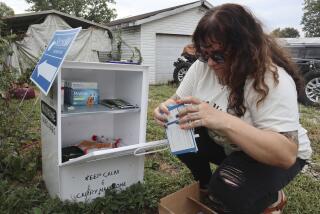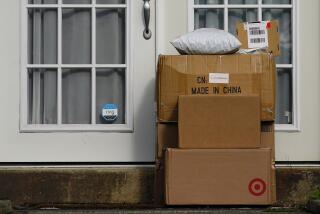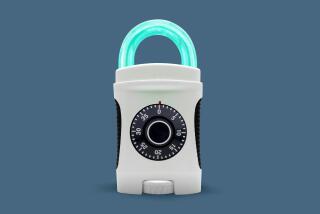Packages No Cure-All to Product-Tampering
It didnât matter that Sudafed 12-hour capsules came in tamper-resistant packaging. Someone got into them anyway last month, lacing them with cyanide that left two people dead and one ill. And while Burroughs Wellcome, which makes Sudafed, issued a nationwide recall, federal and state officials found several more deadly packages.
Everyone seems surprised that this could have happened. Didnât the government put in tougher packaging regulations since cyanide-contaminated Tylenol capsules killed seven people in Chicago in 1982? Havenât manufacturers changed their packaging? Arenât consumers more watchful?
Yes, on all counts. But despite understandable efforts to place blame somewhere, such crimes may be unpreventable. âThe government does its best, industry does its best, and the consumer does his best,â says John T. Walden, senior vice president of the Nonprescription Drug Manufacturers Assn. in Washington, âand these criminals are still going to get a few people.â
Before the 1982 fatalities, pill packaging was more trusting. The Tylenol box, like many over-the-counter medicines, was unsealed, the pills bottled with a wad of cotton under a flip-off plastic cap. Whoever was responsible was never caught, and the exact method of adulteration was never publicly disclosed. But preventive measures began immediately.
Tampering or threatening to tamper with such medicines was made a federal crime. The Food and Drug Administration quickly ruled that nonprescription capsules must be packaged with at least one of 11 tamper-resistant safeguards on capsule, bottle, or box--tapes on the box flaps, shrink-wrapped plastic around bottle caps, blister packs. None were actually tamper-proof, but âtamper-evident,â meaning âthey donât make it harder to get in,â says Walden, âbut harder to get in without leaving tracks.â
Some companies went further, following the lead of Johnson & Johnson, which makes Tylenol. When Tylenol capsules, quickly recalled, came back on the market, they had what a company spokesman calls âthe best tamper-evident packagingâ possible, their outer box glued shut, a plastic-covered bottle, heat-sealed aluminum across the mouth of the bottle.
Nevertheless, in 1986, poisoned Excedrin caused two fatalities in Washington, and poisoned Tylenol caused one in New York. (The wife of one of the victims was convicted in the Excedrin case.) All involved cyanide-tainted capsules; all had tamper-evident packaging.
At that point, Johnson & Johnson gave up capsules entirely. Other companies stuck with capsules, given their perceived appeal as easy to swallow and more medicinal-looking, but adopted two and sometimes three tamper-resistant closures. And the FDA amended its earlier rule, making at least two tamper-resistant features mandatory as of 1990.
The tainted Sudafed capsules still surfacing in the Seattle area--six packages so far--had a blue gelatin safety band joining the capsuleâs two halves, were sealed into individual blister units, and packed in a tape-closed box. And âthe product label,â says Burroughs Wellcome spokesman Sharon Haggerty, âalerts the consumer to be aware of any change to these special features.â
Indeed, the changes were evident, even clumsy. According to the FDA, the box tapes were slit, the blister packâs foil backing cut and put back in place, the capsuleâs blue safety band removed. Tainted capsules, moreover, were oversized and filled with powder rather than tiny beads.
Itâs a foolish illusion that the problem is strictly one of capsules and cyanide--though that must seem an effective combination to a demented mind--or capsules and any poison, or even just capsules. If capsules are banned (as the FDA is considering), someone will put poisoned coating onto tablets or poison into liquid medicines.
Itâs not even just medicine. No product is safe. There has been pesticide put in juice (causing deaths in Japan in 1985), glass shards in ice cream containers, cyanide in a couple of Chilean grapes and enough reports of razor blades in Halloween apples to cause the virtual cancellation of Halloween.
As for the packaging, over-the-counter medicines could be sealed in tin cans and someone would find a way in. As Haggerty says, and everyone agrees, âno package can be absolutely tamper-proof,â although tamper-resistant or tamper-evident features can help, giving consumers--whose vigilance is last and most important--some chance to spot a violation.
In 1986, Johnson & Johnson Chairman James Burke rightly called such pill-poisonings âacts of terrorism,â and pleaded for everyone to work together toward a solution. But terrorism is random, impossible to predict, difficult to protect against. There is no way to mount defenses everywhere it could surface. There is no defense that cannot be defeated.
Sure, government, industry, and consumers can all be more vigilant. But vigilance starts with the recognition that life canât be made tamper-proof.
MAKING PACKAGING TAMPER-RESISTANT These are some of the packaging methods recognized by the Food and Drug Administration. Each provides a barrier to entry or leaves an indicator when opened: FILM WRAPPER: Transparent film with distinctive design wrapped around product or container; must be cut or torn off.
BLISTER OR STRIP PACK: Single doses are sealed in plastic or foil that must be cut or torn.
BUBBLE PACK: Product or container sealed in plastic and mounted to display card. Product is âpoppedâ out.
SHRINK SEALS and BAND: Plastic with distinctive design or printing; must be cut or torn.
FOIL, PAPER or PLASTIC POUCH: for individual products, must be torn or broken.
BOTTLE SEAL: Paper or foil with distinctive design or printing sealed over mouth of container; must be cut.
TAPE SEAL: Distinctively designed paper or foil that is sealed over carton flaps or bottle cap and is torn off.
BREAKABLE CAP: The cap either breaks away or leaves a portion attached to container.
SEALED TUBE: Mouth of tube is sealed with metal and must be punctured.
SEALED CARTON: Flaps are securely sealed, and carton must be damaged or destroyed to remove product.
More to Read
Inside the business of entertainment
The Wide Shot brings you news, analysis and insights on everything from streaming wars to production â and what it all means for the future.
You may occasionally receive promotional content from the Los Angeles Times.










